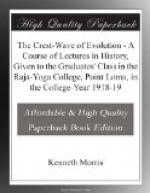------ * Encyclopaedia Britannica, article ‘Ireland’; whence all re Findian and the colleges. ------
The truth is, we seem to have in it the relics and wreckage of the literary output of a whole foregone manvantara, or perhaps several. For in the vast mass of epics and romances that comes down, one distinguishes three main cycles: the Mythological, the Red Branch, and the Fenian. The first deals with the Five Races that invaded or colonized Ireland: Partholanians, Nemedians, Firbolgs, Gods, and Irish;—in all of it I suspect the faint memories and membra disjecta of old, old manvantaras: indeed, the summing up of the history of created man. You will have noted that the number of the races, as in Theosophic teaching, is five. M. de Jubainville points out that the creation of the world, or its gradual assumption of its present form, goes on pari passu with the evolution of its humanities, and under their eyes; thus, when Partholan, the first invader, arrived, there were but three lakes in Ireland, and nine rivers, and one plain. This, too, is an echo of the secret doctrine; and incidentally indicates how tremendously far back that first invasion was thought to have been.
The Partholanians came into Ireland from the Great Plain, the “Land of the Living,” as the Irish called it, which is also the Land of the Dead:—in other words, they came into this world, and not from another part of it. Their peculiarity was that they were “no wiser the one than the other “; an allusion to the mindlessness of the early humanities before the Manasaputra incarnated in the mid-Third Root Race. Again, before their coming, there was a people in Ireland called the Fomorians: they came up from the sea, were gigantic and deformed; some of them with but one foot or one arm, some with the heads of horses or goats. That will remind you of the “water-men, terrible and bad” in the Stanzas of Dzyan: the first attempts of the Earth or unaided Nature to create men. But when the Partholanians fought with and defeated these Fomoroh, they were said to have “freed Ireland from a foreign foe”; this though the Fomorians were there first, and though the Partholanians were “invaders,” and utterly ceased to be after a time, so that no drop of their blood runs in Irish veins. Why, then, does Ireland identify itself with the one race, and discard the other as “foreign foes"?— Because the Partholanians represent the first human race, but the Fomoroh or ‘Water-men’ were unhuman, and a kind of lusus naturae. ‘Fomoroh,’ by the way, may very well be translated ‘Water-men’; fo I take to be the Greek upo, ‘under,’ and ‘mor’ is the ‘sea.’ Now the Battle of Mag Itha, between Partholan and the Fomorians, is a very late invention; not devised, I think, until the eleventh century. And of course there was no war or contact between the First Race and the Water-men, who had been destroyed long before. This is a good example of what came down in Pagan Ireland, and how the Christian redactors treated it. They had heard of the existence of the Fomoroh before the coming of Partholan, and thought it wise to provide the latter with a war against them. Later, as we shall see, the Fomoroh stood for the over-sea people westward,—the Atlantean giant-sorcerers.




